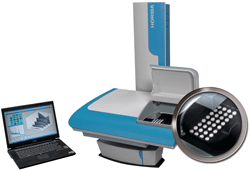A new approach to quality control and cost reduction in manufacturing
Posted: 27 October 2011 | | No comments yet
Raman spectroscopy, a technology that has a long pedigree of success in Pharmaceutical Development…


Introduction
The focus of this article is Raman spectroscopy, a technology that has a long pedigree of success in Pharmaceutical Development but has needed an evolutionary step to tech transfer effectively into Pharmaceutical Production. This change has now come through an innovative approach to whole tablet and capsule measurement called Transmission Raman Spectroscopy (TRS). There is now a flurry of activities across the industry to implement this technology into key unit processes and as a new opportunity to support a robust Real Time Release (RTR) strategy.


The successes for Raman Spectroscopy in Pharmaceutical Development have been for materials analysis, and in support of product and process development and optimisation. Published work on how the technology has been exploited based on early phase development for proof of structure; drug substance salt and morphology identification, and later phase development such as granule imaging, tablet imaging and whole tablet/capsule analysis, has demonstrated the added value that this platform can bring by transferring to a manufacturing environment. Todate, Raman spectroscopy has not embedded into a manufacturing process, though it is established for trouble-shooting, raw materials screening and, once in the commercial market, for counterfeit surveillance. However, broader exploitation is now feasible through this evolutionary step in the TRS technology. This now makes Raman a preferred technology platform that warrants the effort needed to tech transfer into manufacturing thereby meeting the increased demands for appropriate CQAs.
More about the technology
Raman spectroscopy exploits a well known optical effect whereby a tablet is exposed to a laser beam. The interaction of the light with the sample components represents a response for both the chemical and physical properties. In fact the response is also quantitative. In the analysis of tablets, this response gives a complete picture of the components and their concentrations. This principle drives its strategic use for measurements in tablet manufacturing. In reality, Raman is only sensitive at the right specification level for certain CQAs but with few limitations. The key properties are assessment for potency, batch variability, uniformity of content (UOC) and morphology in the drug product. Depending upon the dosage level and the specification requirements for errors in prediction, the measurement time is of the order of 1 second per sample, though may be significantly less.
An application that is receiving most attention is UOC, where it can speed up the batch release testing process significantly and reduce batch hold times. In Development, the feedback of test results can help optimize the process and thus improve specifications for batch quality.
Where Next
Instrument manufacturers are actively developing means to improve the detection limits, the speed of measurement and the robustness of the analysis model. Analysis speed of 1 s/sample can be routinely achieved, and it is only getting faster. The calibration models with as few as two calibration points test remarkably well. The technology is now at a stage where we can really start to benefit from the robustness and simplicity that has been demonstrated for specific key unit processes.
What must follow is the implementation strategy for use of Raman in manufacturing processes. It is as important, if not more, in order to define how the technology can drive new ways of working with all the needed added benefits to cost and time.
Raman is on the verge of becoming a widespread tool in pharmaceutical manufacturing.




